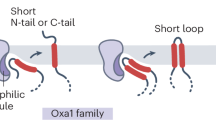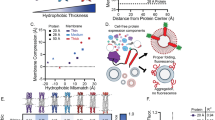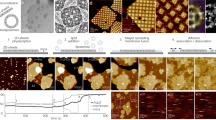Abstract
We have designed integral membrane proteins with one, two and four hydrophobic transmembrane segments of highly simplified amino acid composition and with appropriately placed positively charged lysine residues intended to control the overall membrane orientation. When expressed in Escherichia coli, these model proteins insert efficiently into the inner membrane and adopt the predicted topologies. This demonstrates the feasibility of de novo design of multi-spanning integral membrane proteins, and opens up new possibilities for membrane protein engineering.
This is a preview of subscription content, access via your institution
Access options
Subscribe to this journal
Receive 12 print issues and online access
$259.00 per year
only $21.58 per issue
Buy this article
- Purchase on SpringerLink
- Instant access to full article PDF
Prices may be subject to local taxes which are calculated during checkout
Similar content being viewed by others
References
Lovejoy, B. et al. Crystal structure of a synthetic triple-stranded α-helical bundle Science 259, 1288–1293 (1993).
Kamtekar, S., Schiffer, J.M., Xiong, H., Babik, J.M. & Hecht, M.H. Protein design by binary patterning of polar and nonpolar amino acids. Science 262, 1680–1685 (1993).
Hecht, M.H., Richardson, J.S., Richardson, D.C. & Ogden, R.C. De novo design, expression, and characterization of felix - A 4-helix bundle protein of native-like sequence. Science 249, 884–891 (1990).
Robertson, D.E. et al. Design and synthesis of multi-haem proteins. Nature 368, 425–432 (1994).
Harbury, P.B., Zhang, T., Kim, P.S. & Alber, T. A switch between two-, three-, and four-stranded coiled coils in GCN4 leucine zipper mutants. Science 262, 1401–1407 (1993).
Yan, Y.B. & Erickson, B.W. Engineering of betabellin 14D: Disulfide-induced folding of a beta-sheet protein. Prot. Sci 3, 1069–1073 (1994).
Quinn, T.P., Tweedy, N.B., Williams, R.W., Richardson, J.S. & Richardson, D.C. Betadoublet: De novo design, synthesis, and characterization of a β-sandwich protein. Proc. natn. Acad. Sci. U.S.A 91, 8747–8751 (1994).
Hecht, M.H. De novo design of β-sheet proteins. Proc. natn. Acad. Sci. U.S.A. 91, 8729–8730 (1994).
Cowan, S.W. & Rosenbusch, J.P. Folding pattern diversity of integral membrane proteins. Science 264, 914–916 (1994).
von Heijne, G. & Manoil, C. Membrane proteins -from sequence to structure. Prot. Engng. 4, 109–112 (1990).
von Heijne, G. Membrane proteins: from sequence to structure. A. Rev. Biophys. biomolec. Struct. 23, 167–192 (1994).
Boyd, D. & Beckwith, J. The role of charged amino acids in the localization of secreted and membrane proteins. Cell 62, 1031–1033 (1990).
Dalbey, R.E. Positively charged residues are important determinants of membrane protein topology. Trends Biochem Sci. 15, 253–257 (1990).
Gafvelin, G. & von Heijne, G. Topological “frustration” in multi-spanning E. coli inner membrane proteins. Cell 77, 401–412 (1994).
Schatz, P.J. & Beckwith, J. Genetic analysis of protein export in Escherichia coli. A. Rev. Genet. 24, 215–248 (1990).
Wickner, W., Driessen, A.J.M. & Hartl, F.U. The enzymology of protein translocation across the Escherichia coli plasma membrane. A. Rev. Biochem. 60, 101–124 (1991).
Andersson, H. & von Heijne, G. Sec-dependent and sec-independent assembly of E. coli inner membrane proteins - the topological rules depend on chain length. EMBO J. 12, 683–691 (1993).
Kuhn, A. Alterations in the extracellular domain of M13 procoat protein make its membrane insertion dependent on secA and secY. E. J. Biochem. 177, 267–271 (1988).
Wolfe, P.B., Wickner, W. & Goodman, J.M. Sequence of the leader peptidase gene of Escherichia coli and the orientation of leader peptidase in the bacterial envelope. J. biol. Chem. 258, 12073–12080 (1983).
von Heijne, G., Wickner, W. & Dalbey, R.E. The cytoplasmic domain of Escherichia coli leader peptidase is a “translocation poison: sequence”. Proc. natn. Acad. Sci. U.S.A. 85, 3363–3366 (1988).
Oliver, D.B., Cabelli, R.J., Dolan, K.M. & Jarosik, G.R. Azide-resistant mutants of Escherichia coli alter the Sec A-protein, an azide-sensitive component of the protein export machinery. Proc. natn. Acad. Sci. U.S.A. 87, 8227–8231 (1990).
Manoil, C. Analysis of membrane protein topology using alkaline phosphatase and β-galactosidase gene fusions. Meths. Cell Biol. 34, 61–75 (1991).
von Heijne, G. Control of topology and mode of assembly of a polytopic membrane protein by positively charged residues. Nature 341, 456–458 (1989).
Johnston, S., Lee, J.H. & Ray, D.S. High-level expression of M13 gene II protein from an inducible polycistronic messenger RNA. Gene 34, 137–145 (1985).
Dalbey, R.E. & Wickner, W. The role of the polar, carboxyl-terminal domain of Escherichia coli leader peptidase in its translocation across the plasma membrane. J. biol. Chem. 261, 13844–13849 (1986).
Dalbey, R.E. & Wickner, W. Leader peptidase of Escherichia coli: critical role of a small domain in membrane assembly. Science 235, 783–787 (1987).
Gutierrez, C. & Devedjian, J.C. A plasmid facilitating in vitro construction of phoA gene fusions in Escherichia coli. Nucleic Acids Res. 17, 3999 (1989).
Kunkel, T.A. Rapid and efficient site-specific mutagenesis without phenotypic selection. Proc. natn. Acad. Sci. U.S.A. 82, 488–492 (1985).
Geisselsoder, J., Witney, F. & Yuckenberg, P. Efficient site-directed in vitro mutagenesis. BioTechniques 5, 786–791 (1987).
Calamia, J. & Manoil, C. Membrane protein spanning segments as export signals. J. molec Biol. 224, 539–543 (1992).
Michaelis, S., Inouye, H., Oliver, D. & Beckwith, J. Mutations that alter the signal sequence of alkaline phosphatase in Escherichia coli. J. Bacteriol. 154, 366–374 (1983).
San Millan, J.L., Boyd, D., Dalbey, R., Wickner, W. & Beckwith, J. Use of PhoA fusions to study the topology of the Escherichia coli innermembrane protein leader peptidase. J. Bacteriol. 171, 5536–5541 (1989).
Gennity, J.M., Kim, H. & Inouye, M. Structural determinants in addition to the amino-terminal sorting sequence influence membrane localization of Escherichia-Coli lipoproteins. J. Bacteriol. 174 2095–2101 (1992).
Author information
Authors and Affiliations
Rights and permissions
About this article
Cite this article
Whitley, P., Nilsson, I. & Heijne, G. De novo design of integral membrane proteins. Nat Struct Mol Biol 1, 858–862 (1994). https://doi.org/10.1038/nsb1294-858
Received:
Accepted:
Issue date:
DOI: https://doi.org/10.1038/nsb1294-858
This article is cited by
-
Small-residue packing motifs modulate the structure and function of a minimal de novo membrane protein
Scientific Reports (2020)
-
The de novo design of a biocompatible and functional integral membrane protein using minimal sequence complexity
Scientific Reports (2018)
-
Simple surface functionalization of polymersomes using non-antibacterial peptide anchors
Journal of Nanobiotechnology (2016)
-
Membrane protein orientation and refinement using a knowledge-based statistical potential
BMC Bioinformatics (2013)
-
Membrane proteins up for grabs
Nature Biotechnology (2007)



